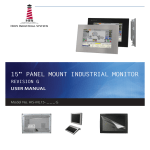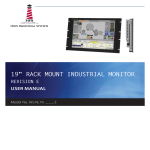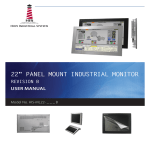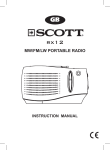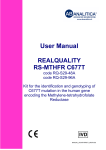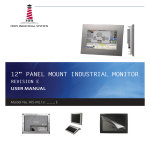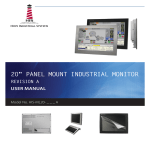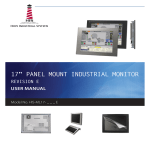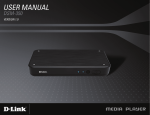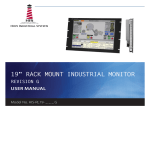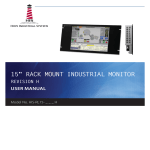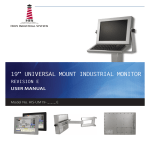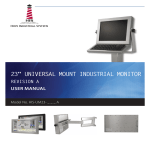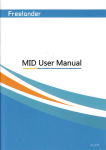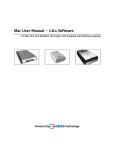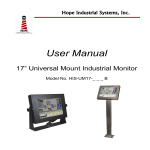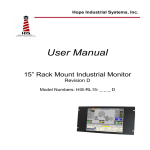Download USER MANUAL - I
Transcript
19” RACK MOUNT INDUSTRIAL MONITOR USER MANUAL Model: HRM819TR i-Tech Company LLC TOLL FREE: (888) 483-2418 email: [email protected] web: www.iTechLCD.com Table of Contents Safety and Regulatory Information ................................................................................... 3 FCC Notice ........................................................................................................................................... 3 Waste Electrical and Electronic Equipment Directive (WEEE).............................................................. 4 Mechanical Drawings ....................................................................................................... 5 Front View ............................................................................................................................................ 5 Bottom View ......................................................................................................................................... 5 Side View.............................................................................................................................................. 6 Installation Instructions ................................................................................................... 7 Step 1: Prepare for Installation ............................................................................................................. 7 Step 2: Bench-test Confguration........................................................................................................... 8 Install Touchscreen Driver................................................................................................................. 9 Step 3: Install into Rack ...................................................................................................................... 11 Video Settings ................................................................................................................ 12 Setting the Timing Mode ..................................................................................................................... 12 Control Panel Buttons ......................................................................................................................... 13 OSD and Power Lock Settings ........................................................................................................... 14 On-Screen Display (OSD) Menus ....................................................................................................... 15 Auto Image Adjust Menu ................................................................................................................ 15 Contrast / Brightness Menu ............................................................................................................ 16 Input Select Menu .......................................................................................................................... 16 Color Adjust Menu .......................................................................................................................... 16 Information Menu ........................................................................................................................... 17 Manual Image Adjust Menu............................................................................................................. 18 Setup Menu .................................................................................................................................... 19 Cleaning Instructions...................................................................................................... 20 Glass, Acrylic, and Touchscreen Window Models .............................................................................. 20 No Protective Wndow (LCD Surface) Models ..................................................................................... 20 Troubleshooting ............................................................................................................. 21 Video Troubleshooting ........................................................................................................................ 21 Touchscreen Troubleshooting ............................................................................................................ 23 Specifcations ................................................................................................................. 24 Display ................................................................................................................................................ 24 Environmental .................................................................................................................................... 24 Video .................................................................................................................................................. 25 Electrical ............................................................................................................................................. 25 Functional ........................................................................................................................................... 25 Rack Compatibility .............................................................................................................................. 26 Physical .............................................................................................................................................. 26 Compliances and Certifcations ........................................................................................................... 26 2 Safety and Regulatory Information Safety and Regulatory Information WARNING! To prevent fire or shock hazard, do not expose the unit to rain or moisture. Dangerously high voltages are present inside the unit. Do not disassemble the unit. Refer servicing to qualifed personnel only. This equipment is not intended for use in critical applications where its failure to operate would create immediate life threatening circumstances. Applications including, but not limited to, nuclear reactor control, aerospace navigation systems and life support systems are not appropriate for this product. To be covered by UL 60950 3rd Edition, the socket-outlet shall be installed near the equipment and shall be easily accessible. FCC Notice This equipment has been tested and found to comply with the limits for a Class A digital device, pursuant to Part 15 of the FCC Rules. These limits are designed to provide reasonable protection against harmful interference when the equipment is operated in a commercial environment. This equipment generates, uses, and can radiate radio frequency energy and, if not installed and used in accordance with the instruction manual, may cause harmful interference to radio communications. Operation of this equipment in a residential area is likely to cause harmful interference in which case the user will be required to correct the interference at his own expense. Any changes or modifcations not expressly approved by the grantee of this device could void the user’s authority to operate the device. 3 Safety and Regulatory Information Waste Electrical and Electronic Equipment Directive (WEEE) The following information is only for EU-member states: The mark shown to the right is in compliance with the Waste Electrical and Electronic Equipment Directive 2002/96/EC (WEEE). The mark indicates the requirement NOT to dispose of the equipment as unsorted municipal waste, but use the return and collection systems according to local law. Users should contact their supplier and check the terms and conditions of the purchase contract. When purchased directly from Hope Industrial Systems, you may contact technical support for disposal arrangements. 4 Mechanical Drawings Mechanical Drawings Front View Bottom View 5 Mechanical Drawings Side View 6 Installation Instructions Installation Instructions Step 1: Prepare for Installation IMPORTANT! Perform the following steps BEFORE installation of the monitor into the rack. 1. Ensure that suffcient power is available. 2. Ensure that suffcient space is available to allow for proper air fow into and out of the unit. 3. Ensure that the air temperature around the unit (top and bottom) will not exceed the rated specifcations of the unit. The maximum rated temperature for the HRM819TR is 50°C (122°F). ► Remember that heat rises - the temperature at the top of the cabinet will be much hotter than at the bottom if air inside the enclosure is not actively circulating. Even in a sealed enclosure, use of a circulation fan can greatly reduce temperature. ► Also, remember that even though this product is designed to operate at 50°C, the life span of any electronic device is shortened when it is consistently operated at high temperatures. Therefore, it is wise to take steps to keep the temperature of the ambient air around the unit as low as possible. 4. Ensure that the ambient humidity of the air around the unit does not exceed the specifcations of the unit. ► The maximum rated is 90% non-condensing. humidity for the HRM819TR 7 Installation Instructions Step 2: Bench-test Confguration Make sure everything works before installing into the production environment. TIP! If using a KVM extender, please refer to the installation instructions included with the KVM extender module. It is particularly important to bench-test the full confguration prior to final installation. This will help to identify and troubleshoot any system issues while confguration changes may still be easily made. Install Cable Connections All monitors are shipped with both a 6 ft. VGA video cable and 6 ft. power cable, unless longer cables were ordered in their place. If you ordered a touchscreen monitor, you also received a 6 ft. Serial (RS-232) cable and 6 ft. USB cable. The cable ports are located on the rear of the monitor. Refer to the following diagram and instructions to connect power, video, and touchscreen (if applicable) to your monitor. Video Connection The HRM819TR supports analog and digital video. Analog Video Connection Connect one end of the VGA video cable to the HD-15 input port on the rear of the monitor. Connect the other end to the analog video output port on the host computer. 8 Installation Instructions Digital Video Connection Connect one end of the DVI video cable to the DVI-D input port on the rear of the monitor. Connect the other end to the digital video output port on the host computer. Power Connection The HRM819TR is powered by 120/240 VAC, 1.5/0.75 A, 60/50 Hz. Connect the AC power cable to the power input port on the rear of the monitor. Connect the other end into a nearby outlet. Install Touchscreen Driver Applies to touchscreen monitors only. Instructions below apply to Windows systems. Both Serial and USB ports are present on all touchscreen monitors, but only one should be used to connect the touchscreen interface to the monitor. All touchscreen monitors are shipped with a CD-ROM that contains documentation and drivers for all major operating systems. To be sure that you have the most current information, please check the following Internet address: http://www.i-techcompany.com/support-top.html IMPORTANT! If you will be using a Serial connection, connect the Serial cable frst, and then install the touchscreen driver. If you will be using a USB connection, install the touchscreen driver frst, and then connect the USB cable. Serial (RS-232) Connection 1. Connect one end of the Serial cable to the Serial input port on the rear of the monitor. Connect the other end to the Serial port on the host computer. Tighten the captive screws on the cable connectors to ensure adequate strain relief. 9 Installation Instructions 2. Select the appropriate driver for your operating system. a. If downloading from the web address listed above, select the appropriate driver for your operating system. b. If using the included CD, insert it into the host computer's CD-ROM drive. If the CD does not automatically run, browse the contents of the CD and open the ReadMe.htm fle in a web browser. Select the appropriate driver. NOTE: For Windows 7 and Vista operating systems, you must save the driver to a location on your hard drive, then run using elevated privileges by right-clicking on the fle and selecting "Run as administrator". 3. Click to "Run" the software when prompted. Follow on-screen instructions to download and execute the touchscreen driver installation. USB Connection 1. Select the appropriate driver for your operating system. a. If downloading from the web address listed above, select the appropriate driver for your operating system. b. If using the included CD, insert it into the host computer's CD-ROM drive. If the CD does not automatically run, browse the contents of the CD and open the ReadMe.htm fle in a web browser. Select the appropriate driver. NOTE: For Windows 7 and Vista operating systems, you must save the driver to a location on your hard drive, then run using elevated privileges by right-clicking on the fle and selecting "Run as administrator". 2. Click to "Run" the software when prompted. Follow on-screen instructions to download and execute the touchscreen driver installation. 3. A cable retention bracket comes installed on the USB port on the rear of the monitor and will help to secure the cable and ensure adequate strain relief. Route one end of the USB cable through the retention bracket and connect it to the USB input port on the monitor. Connect the other end to the USB port on the host computer. Calibrate the Touchscreen Once the driver has fnished installing, you are ready to calibrate the touchscreen. Open the touchscreen's Control Panel, located in the host computer's Control Panel. NOTE: The latest versions of Wndows touchscreen drivers provided by Hope Industrial have an "Enhanced Calibration Mode" option. If applicable to your particular driver, this setting may be found in the touchscreen's Control Panel under the "Mode" tab. 10 Installation Instructions Step 3: Install into Rack Once you have completed the full bench-test confguration and confrmed that all components are working properly, you are ready to install the monitor into the rack. Hope Industrial Systems' Rack Mount monitors conform to the Electronic Industries Association standard EIA-310-D. Our monitors will ft in type A, B, and C racks with a width of 482.6 mm (19") (preferred EIA rack width). WARNING! i-Tech will not assume liability for damage to internal electronics due to improper installation. Contact HIS if you need additional assistance. The HRM819TR has a panel height of 8U (shown below). 0" 37.5 mm (1.48") 316.9 mm 139.1 mm (5.48") (12.48" 215.3 mm (8.48" 354.3 mm (13.95") 8U (13.95”) Video Settings Video Settings Setting the Timing Mode Setting the timing mode of your computer graphics adapter (or other video source) is important for maximizing the quality of the screen image and for minimizing eye strain. The timing mode consists of the resolution (e.g. 1280 x 1024) and refresh rate (or vertical frequency; e.g. 60 Hz). After setting the timing mode, use the On-Screen Display (OSD) controls to adjust the screen image. TIP! For the best picture quality, set your computer graphics adapter timing mode to: VESA 1280 x 1024 @ 60 Hz Please refer to the computer graphics adapter manufacturer's manual for instructions on setting the resolution and timing mode. In Microsoft Windows, these settings may be found at the following location: ► ME, 2000, XP: Control Panel > Display > Settings ► Vista: Control Panel > Personalization > Display Settings ► Windows 7: Control Panel Adjust Screen Resolution > Appearance and Personalization > WARNING! Do not set the graphics card in your computer to exceed the maximum refresh rate of 75 Hz; doing so may result in permanent damage to your display. 12 Video Settings Control Panel Buttons Use the control panel buttons located on the back of the monitor to display and adjust various settings on the On-Screen Display (OSD) menu. 1. To display the Main Menu, press button [1]. NOTE: All OSD menus and adjustments screens disappear automatically after 15 seconds. This is adjustable through the OSD Time Out setting in the Setup menu. 2. To select a control to adjust, press the up [▲] or down [▼] button to scroll through the menu. 3. Press button [2] to open the menu for a selected control. 4. To adjust the control, press the up [▲] or down [▼] button. 5. To save the adjustments and return to the main OSD menu, press button [1] once. To exit the OSD menu, press button [1] twice. 13 Video Settings . OSD and Power Lock Settings ► OSD Lock: Press and hold [1] and the up [▲] button for 10 seconds. If any buttons are pressed the message OSD Locked will display for 3 seconds. ► OSD Unlock: Press and hold [1] and the up [▲] button again for 10 seconds. ► Power Button Lock: Press and hold [1] and the down [▼] button for 10 seconds. If the power button is pressed, the message Power Button Locked will display for 3 seconds. With or without this setting, after a power failure, your monitor's power will automatically turn ON when power is restored. ► Power Button Unlock: Press and hold [1] and the down [▼] button again for 10 seconds. 14 Video Settings On-Screen Display (OSD) Menus To open the OSD menu, press button [1] once. The following screen will appear: Main Menu Description Auto Image Adjust Automatically sizes, centers, and fne tunes the video signal to eliminate waviness and distortion. Contrast / Brightness Includes the Contrast and Brightness functions. Input Select Allows the user to toggle between inputs. Color Adjust Provides several color adjustment modes. Information Displays the timing mode (video signal input). Manual Image Adjust Includes the H./V. Position, Horizontal Size, Fine Tune, Sharpness, Dynamic Contrast, and ECO Mode functions. Setup Menu Includes the Language Select, Resolution Notice, OSD Position, OSD Time Out, OSD Background, and Auto Power Off functions. Memory Recall Returns adjustments back to factory settings. Auto Image Adjust Menu The Auto Image Adjust menu automatically sizes, centers, and fne tunes the video signal to eliminate waviness and distortion. NOTE: Auto Image Adjust works with most common video cards. If this function does not work on your display, lower the video refresh rate to 60 Hz and set the resolution to its pre-set value. 15 Video Settings Contrast/ Brightness Menu The Contrast/Brightness menu includes the Contrast and Brightness functions. Contrast / Brightness Menu Description Contrast • • Brightness • • Adjusts the difference between the image background (black level) and the foreground (white level). This feature may also be accessed by pressing the up [▲] button outside of the OSD menu. Adjusts the background black level of the screen image. This feature may also be accessed by pressing the down [▼] button outside of the OSD menu. Input Select Menu The Input Select menu allows the user to toggle between inputs if there is more than one computer connected to the display. Color Adjust Menu The Color Adjust menu provides several color adjustment modes, including preset color temperatures and a User Color mode which allows independent adjustment of red (R), green (G), and blue (B). The factory setting for this product is 6500K (6500 Kelvin). 16 Video Settings Color Adjust Menu Description sRGB This is quickly becoming the industry standard for color management, with support being included in many of the latest applications. Enabling this setting allows the LCD to more accurately display colors the way they were originally intended. NOTE: Enabling the sRGB setting will cause the Contrast and Brightness adjustments to be disabled. 9300K Adds blue to the screen image for cooler white (used in most offce settings with fuorescent lighting). 7500K Adds blue to the screen image for cooler white (used in most offce settings with fuorescent lighting). 6500K Adds red to the screen image for warmer white and richer red. 5000K Adds green to the screen image for a daylight color. User Color Individual adjustments for red (R), green (G), and blue (B). 1. To select color (R, G, or B) press button [2]. 2. To adjust selected color, press the up [▲] or down [▼] button. NOTE: If you select RECALL from the OSD Main Menu when the product is set to a Preset Timing Mode, colors return to the 6500K factory preset. Information Menu The Information menu displays the timing mode (video signal input) coming from the graphics card in the computer. See your graphics card's user guide for instructions on changing the resolution and refresh rate (vertical frequency). NOTE: VESA 1280 x 1024 @ 60 Hz (recommended) means that the resolution is 1280 x 1024 and the refresh rate is 60 Hz. 17 Video Settings Manual Image Adjust Menu The Manual Image Adjust menu includes the H./V. Position, Horizontal Size, Fine Tune, Sharpness, Dynamic Contrast, and ECO Mode functions. Manual Image Adjust Menu Description H./V. Position (Horizontal / Vertical Position) Moves the screen image left or right and up or down. Horizontal Size Adjusts the width of the screen image. Fine Tune Sharpens the focus by aligning text and/or graphics with pixel boundaries. NOTE: Try the Auto Image Adjust function frst. Sharpness Adjusts the clarity and focus of the screen image. Dynamic Contrast Allows the user to turn the contrast ratio enhancement On or Off. Dynamic Contrast adjusts the brightness of the backlights to improve the contrast of the screen image (darker screen images will have better black levels). ECO Mode Provides lower power consumption by reducing the brightness. 18 • Standard is the default brightness setting • Optimize reduces brightness by 25% • Conserve reduces brightness by 50% Video Settings Setup Menu The Setup menu includes the Language Select, Resolution Notice, OSD Position, OSD Time Out, OSD Background, and Auto Power Off functions. Setup Menu Description Language Select Allows the user to choose the language used in the menus and control screens. Resolution Notice Advises the optimal resolution to use. OSD Position Allows the user to move the OSD menus and control screens. OSD Time Out Sets the length of time the OSD screen is displayed. For example, with a "15 second" time setting, if a control is not pushed within 15 seconds, the display screen disappears. OSD Background Allows the user to turn the OSD background On or Off. Auto Power Off When enabled, this setting will automatically power off the monitor when no signal is detected for 3 minutes. Memory Recall Menu The Memory Recall menu returns adjustments back to factory settings. NOTE: This control does not affect changes made with the Language Select or Power Lock settings. 19 Cleaning Instructions Cleaning Instructions CAUTION! DO NOT USE ABRASIVE MATERIALS, SUCH AS PAPER TOWELS OR DIRTY SHOP RAGS, ON THE DISPLAY AS IT WILL SCRATCH THE PROTECTIVE COATING. ALWAYS USE A SOFT CLOTH, PREFERABLY MADE OF COTTON. IMPORTANT! Always spray the cleaner on the cloth or towel frst and then clean the monitor screen. Cleaner sprayed directly on the monitor could possibly leak inside a non-sealed unit and cause damage. Glass, Acrylic, and Touchscreen Window Models All displays with safety glass, acrylic, or resistive touchscreen windows may be cleaned using any standard glass cleaner as long as there is no abrasive or oily content. Vinegar or ammonia will not hurt the screen. The anti-refective coatings on glass window-equipped displays are physically part of the surface of the glass and resist degradation to the Military Specifcations. To minimize over-run of cleaning solution, spray the cloth frst and then clean the screen. No Protective Window (LCD Surface) Models Wipe the screen with a clean, soft, lint-free cloth. This will remove dust and other particles. If the screen is still not clean, apply a small amount of non-ammonia, non-alcohol based glass cleaner onto a clean, soft, lint-free cloth, then wipe the screen. 20 Troubleshooting Troubleshooting Video Troubleshooting IMPORTANT! If using a KVM extender, first try to resolve any problems using the solutions listed below. If the problem still exists, try bypassing the KVM extender. If this fixes the problem and allows the monitor to work properly, then the KVM extender is the source of the problem. Please refer to the troubleshooting section of the KVM extender manual or contact i-Tech for additional assistance. Symptom Causes Solutions No image on the screen and control's Power Indicator light is not lit Monitor is not powered on. • Press the Power button on the monitor and make sure the Power Indicator light is lit blue. • Check power connections at the monitor and power source. "No Signal" Video cable is not plugged in message box and correctly. no image on the PC is in Power Saving screen mode. No image on the screen and control's Power Indicator light is lit orange Check the video cable connection at the monitor, PC, and/or KVM extender. Power Saving mode can usually be exited by moving the mouse. PC is not powered on. Ensure PC is powered on. PC is not sending signal. Connect the PC to another known working monitor to check the PC source signal. Video cable is not plugged in correctly. Check the video cable connection at the monitor, PC, and/or KVM extender. PC is in Power Saving mode. Power Saving mode can usually be exited by moving the mouse. PC is not powered on. Ensure PC is powered on. PC is not sending signal. Connect the PC to another known working monitor to check the PC source signal. 21 Troubleshooting Symptom Causes "Out of Range" message box and no image on the screen The source signal exceeds the Adjust the computer settings to the maximum resolution and/or monitor's native resolution: 1280 x 1024 @ 60 Hz refresh rate that the monitor can handle ( > 1280 x 1024 resolution or > 75 Hz refresh rate). Incorrectly displayed or partial image on the screen Monitor has not been adjusted correctly for the source signal. Wrong or abnormal colors (white is not white) Monitor color settings are incorrectly adjusted. Reset the monitor to the factory default settings by activating the "Memory Recall" function in the OSD. Video cable is not securely connected. If any colors (red, green, or blue) are missing, check the video cable to make sure it is securely connected. Video cable is bad. Check to make sure there are no loose or broken pins in the cable connector. Shorts in the cable could also cause an improper image to display. Screen image is dim Brightness and/or contrast settings are not set properly. Adjust the monitor's brightness and contrast settings in the OSD's "Contrast/ Brightness" menu. The message "OSD Locked" appears The OSD has been locked to prevent unauthorized changes to display settings. Press and hold [1] and the up [▲] button for 10 seconds. The message "Power Button Locked" appears The Power button has been locked to prevent unauthorized shut down of the monitor. Press and hold [1] and the down [▼] button for 10 seconds. 22 Solutions • Activate the "Auto Image Adjust" function in the OSD menu. • Fine tune the picture by manually adjusting the image. In the OSD menu, these functions can be found in the "Manual Image Adjust" menu. Troubleshooting Touchscreen Troubleshooting Applies to touchscreen monitors only. To be sure that you have the most current driver, please check the following Internet address: http://www.i-techcompany.com/support-top.html Symptom Causes Solutions No response when touching the touchscreen Touchscreen driver has not been installed. Download and install the latest driver from the i-Tech website. Touchscreen cable is not plugged in correctly. Make sure either the USB or Serial cable is securely connected to the monitor and PC. Do not connect both. If using a USB connection, does the USB cable length exceed 3 meters? USB cables have a 3 meter limitation and could cause no touch response if this is exceeded. If using a Serial connection, is the Serial cable plugged into the correct COM port? Ensure that the Serial cable is connected to the COM port being used prior to installing the touchscreen driver. Touchscreen driver has not been installed. Download and install the latest driver from the i-Tech website. Touchscreen has not been calibrated. Activate the calibration utility. In Windows systems, these settings may be found at the following location: Control Panel > Elo Touchscreen > "General" Tab • Press the Align button. • Touch all targets as the appear to calibrate the touchscreen. • Press the Green Check button when verifed. The cursor moves but does not follow my finger when touching the touchscreen 23 Specifcations Specifcations Display Type Thin-flm transistor (TFT) Active Matrix Liquid Crystal Size 19" diagonal Image Size (W x H) 376 mm x 301 mm (14.8" x 11.9") Native Resolution SXGA (1280 x 1024, 5:4 aspect ratio) Minimum Resolution VGA (640 x 480) Pixel Pitch 0.294 mm x 0.294 mm Number of Colors 16.7 million Brightness (white) 250 nits (cd/m2) Viewing Angle (Hori/Vert) 170° / 160° Contrast Ratio (typical) 1000:1 (static); 100,000:1 (dynamic) Backlight Two CCFTs (Cold Cathode Fluorescent Tube); 50,000 hour brightness half-life; replaceable Environmental Temperature 0° to 50°C (32° to 122°F) Humidity 20% to 90% non-condensing Operating Shock 15 g, 6 msec, half-sine Operating Vibration (sine) Transport Vibration (random) Altitude 24 1.0g, swept sine 9 - 500 Hz 0.1g2 / Hz, 10 - 200 Hz 0.03g2 / Hz, 200 - 2000 Hz • Operating: up to 10,000 feet • Non-operating: up to 40,000 feet Specifcations Video Input Connectors HD-15, DVI-D NOTE: Optional BNC input using HD-15 to 5-wire BNC adapter; see "Input Signal Formats" for a list of compatible video signals. Input Signal Formats • RGB Analog video, 0.7/1.0 Vp-p, 75 Ohms Compatible sync modes: Separate H/V sync • DVI NOTE: NTSC/PAL composite input available (call for details) Horizontal Scan 30 – 82 kHz Vertical Scan Supported Video Standards 56 – 75 Hz Response Rate (typical) • 1280 x 1024 @ 60, 75 Hz • 1280 x 960 @ 60, 75 Hz • 1024 x 768 @ 60, 70, 72, 75 Hz • 800 x 600 @ 56, 60, 72, 75 Hz • 720 x 400 @ 70 Hz • 640 x 480 @ 60, 75 Hz 5 ms Electrical Monitor Input 120/240 VAC, 1.5/0.75 A, 60/50 Hz Power Consumption ~ 25 W Power Consumption (Standby mode) <1W Functional Control Panel Buttons 1 (Menu), 2 (Enter), Power, Down, Up On-Screen Display (OSD) Menus Touchscreen Option Auto Image Adjust, Contrast / Brightness, Input Select, Color Adjust, Information, Manual Image Adjust, Setup, Memory Recall 5-wire resistive system; emulates a mouse; Serial (RS-232) and USB interface to host computer 25 Specifcations Rack Compatibility EIA Standard EIA-310-D EIA Type Rack A, B, and C Rack Width 482.6 mm (19.0") (preferred EIA width) Mounting 8 Slots, 7.1 mm (0.28") wide Panel Height 8U, 354.3 mm (13.95") Physical Enclosure Type Rack mount Panel Rating Built to IP20 standards; NEMA/UL Type 1 Bezel Finish Black Powder-Coated Carbon Steel, matte fnish Depth Behind Bezel 57.9 mm (2.28") Front Bezel Outside Dimensions (W x H x D) Net Weight 482.6 mm x 354.3 mm x 3.2 mm (19.0" x 13.95" x 0.125") Shipping Weight 19 lbs. 15 lbs. Compliances and Certifcations Electrical Environmental Enclosure 26 • UL 60950 3rd Edition / cUL Recognized Component (File No. E212889) • UL 508A Listed (File No. E318630) • FCC Class A • CE • RoHS (Hazardous Substances) • IEC 60721-3 (Reliability) • WEEE (Registration No. WEE/DJ1859ZX for UK only) UL 50E (File No. E318630)


























